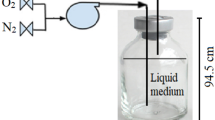Abstract
The growth yield coefficients of phenol as well as of chloro- and methyl-substituted derivatives and the respective phenoxyalkanoic acids have been considered in a theoretical study. The yield coefficient of phenol assimilated via theortho pathway is at a given P/O quotient 9–23% higher than that of themeta route. Chlorine, removed by a reductive mechanism, decreases the yield figure by 10% per chlorine atom; hydrolytic mechanisms are more favourable in this respect. Methylation has a positive effect on the energetics of phenol utilization. Phenoxyacetic acid derivatives have a reduced yield per carbon atom in comparison to the respective phenol derivative. This is compensated for by higher chain lengths of the alkanoic acid moiety. The yield coefficients calculated for phenol correspond to a P/O quotient of 2–3 as compared to the experimental carbon conversion. With chlorinated derivatives, e.g. 2,4-dichlorophenoxyacetic acid or pentachlorophenol, the apparent gain in energy reflects a P/O < 1, indicating uncoupling effects during growth on such compounds.
Similar content being viewed by others
References
Apajalahti JHA, Salkinoja-Salonen MS (1987) Complete dechlorination of tetrachlorohydroquinone by cell extracts of pentachlorophenol-inducedRhodococcus chlorophenolicus. J Bacteriol 169:5125–5130
Babel W (1979) Bewertung von Substraten für das mikrobielle Wachstum auf der Grundlage ihres Kohlenstoff/Energie-Verhdltnisses. Z Allg Mikrobiol 19:671–677
Babel W, Müller RH (1985a) Mixed substrate utilization in microorganisms: biochemical aspects and energetics. J Gen Microbiol 131:39–45
Babel W, Müller RH (1985b) Correlation between cell composition and carbon conversion efficiency in microbial growth: a theoretical study. Appl Microbiol Biotechnol 22:201–207
Babel W, Müller RH (1985c) The influence of carbon catabolism on the auxiliary substrate effect. Acta Biotechnol 5:333–338
Bauchop T, Elsden SR (1960) The growth of microorganisms in relation to their energy supply. J Gen Microbiol 23:457–469
Dagley S (1985) Microbial metabolism of aromatic compounds. In: Moo-Young (ed) Comprehensive biotechnology, vol 1. Pergamon Press, Oxford, pp 483–505
Dietzelmüller G, Loidl M, Streichsbier F (1989) Isolation and characterization of a 2,4-dichlorophenoxyacetic acid-degrading soil bacterium. Appl Microbiol Biotechnol 31:93–96
Hensel J, Straube G (1990) Kinetic studies of phenol degradation byRhodococcus sp. Pl. 11. Continuous cultivation. Antonie van Leeuwenhoek 57:33–36
Janke D, Fritsche W (1985) Nature and significance of microbial cometabolism of xenobiotics. J Basic Microbiol 25:603–619
Klecka GM, Maier WJ (1985) Kinetics of microbial growth on pentachlorophenol. Appl Environ Microbiol 49:46–53
Müller RH, Babel W (1988) Energy and reduction equivalent potential of CZ-compounds for microbial growth. Acta Biotechnol 8:249–258
Müller RH, Babel W (1993) Dinitrophenol influences the rate and yield ofAcetobacter methanolicus during the growth on glucose. Acta Biotechnol 13:243–249
Neijssel OM, Tempest DW, Postma PW, Duine JA, Frank J (1983) Glucose metabolism by K+-limitedKlebsielle aerogenes: evidence for the involvement of a quinoprotein glucose dehydrogenase. FEMS Microbiol Lett 20:35–39
Nishino SF, Spain JC (1993) Cell density-dependent adaptation ofPseudomonas putida to degradation ofp-nitrophenol. Environ Sci Technol 27:489–494
Pieper DH, Engesser KH, Don RH, Timmis KN, Knackmuss HJ (1985) Modifiedortho-cleavage pathway inAlcaligenes eutrophus JMP 134 for the degradation of 4-methylcatechol. FEMS Microbiol Lett 29:63–67
Pieper DH, Reineke W, Engesser KH, Knackmuss HJ (1988) Metabolism of 2,4-dichlorophenoxyacetic acid, 4-chloro -2-methylphenoxyacetic acid and 2-methylphenoxyacetic acid byAlcaligenes eutrophus JMP 134. Arch Microbiol 150: 95–102
Reineke W, Knackmuss HJ (1988) Microbial degradation of haloaromatics. Annu Rev Microbiol 42:263–287
Roels JA (1980) Application of macroscopic principles to microbial metabolism. Biotechnol Bioeng 22:2457–2514
Shaler TA, Klecka GM (1986) Effects of dissolved oxygen concentration on biodegradation of 2,4-D. Appl Environ Microbiol 51:950–955
Sinton GL, Fan LT, Erickson LE, Lee SM (1986) Biodegradation of 2,4-D and related xenobiotic compounds. Enzyme Microb Technol 8:395–403
Steiert JG, Crawford RL (1986) Catabolism of pentachlorophenol by a Flavobacterium sp. Biochem Biophys Res Commun 141:825–830
Stouthamer AH (1973) A theoretical study on the amount of ATP required for the synthesis of microbial cell material.Antonie van Leeuwenhoek 39:545–565
Stouthamer AH (1979) The search for correlation between theoretical and experimental growth yields. Rev Biochem 21:1–47
Tyler JE, Finn RK (1974) Growth rates of a pseudomonad on 2,4-dichlorophenoxyacetic acid and 2,4-dichlorophenol. Appl Microbiol 28:181–184
Van Dijken JP, Harder W (1975) Growth yields of microorganisms on methanol and methane. A theoretical study. Biotecbnol Bioeng 17:15–30
Yang RD, Humphrey AE (1975 Dynamic and steady state studies of phenol biodegradation in pure and mixed culture. Biotechnol Bioeng 17:1211–1235
Author information
Authors and Affiliations
Additional information
Dedicated to Prof. Dr. Fritz Wagner on the occasion of his 65th birthday
Rights and permissions
About this article
Cite this article
Müller, R.H., Babel, W. Phenol and its derivatives as heterotrophic substrates for microbial growth—An energetic comparison. Appl Microbiol Biotechnol 42, 446–451 (1994). https://doi.org/10.1007/BF00902755
Received:
Revised:
Accepted:
Issue Date:
DOI: https://doi.org/10.1007/BF00902755




